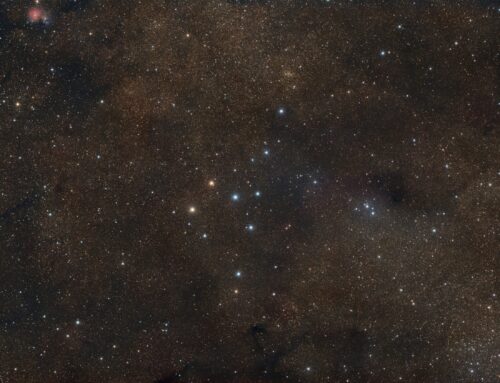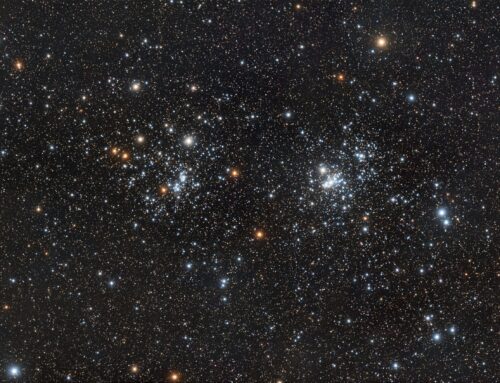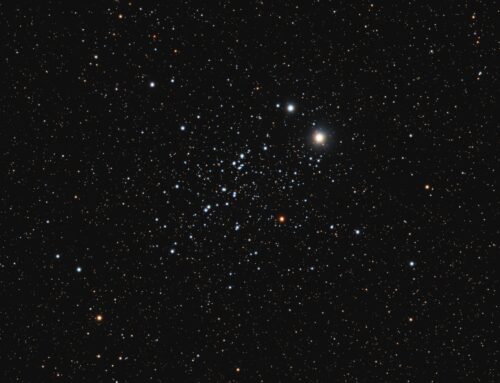NGC 7789 and WY Cas
Click image for full size version
December 21, 2020
Featured Photo, SkyNews.ca, August 29, 2014
“This Week’s Sky”, October 13-20, 2014 at SkyNews.ca
“Amateur Astronomy E-zine, Issue 10, November, 2014
NGC 7789 is shown along with variable star WY Cas, the blinking star in this image. NGC 7789 is one of several objects discovered by Carolyn Herschel, and is sometimes called the White Rose Cluster or Carolyn’s Rose Cluster. It is about 8,000 light years away, and in our home galaxy, the Milky Way. It is an old open cluster, at 1.6 billion years.
WY Cas is a Mira-type variable star. From November 2003 to August 2012, its brightness varied by more than 100x, from a minimum of magnitude 14.8 to as bright as magnitude 9.2. This image shows the star near its brightest on October 9, 2011, and looking much dimmer on August 16, 2012.
Tekkies:
SBIG STL-11000M camera, Baader R, G and B filters, 10″ f/6.8 ASA astrograph, Paramount MX. Guided with QHY5 guide camera and 80 mm f/6 Stellar-Vue refractor. Acquisition, guiding and mount control with TheSkyX. Focusing with FocusMax. Automation with CCDCommander. All preprocessing and post-processing in PixInsight. Shot from my SkyShed in Guelph, Ontario. Acquired August 16, 2012. Good to excellent transparency, and good to very good seeing. Data for WY Cass obtained Oct 9, 2011 with the same equipment and similar conditions, used only for WY Cas.
Data Reduction and Initial Processing
Preprocessing: The WeightedBatchPreProcessing script was used to create integrated master files.
Gradient Removal: DBE was applied to each master using Subtraction.
Luminance Creation: The masters were integrated with ImageIntegration, using Average combination, weighted for noise with no pixel rejection.
Colour
Colour Balancing: Colour was balanced with ColorCalibration.
Linear Noise Reduction: MultiscaleLinearTransform was used to reduce noise in the background areas, using an internal mask to protect bright structures. Layer settings for threshold and strength: Layer 1: 5.0 0.85, 2 iterations; Layer 2: 3.5, 0.75, 2 iterations.
Stretching: HistogramTransformation was applied to make a pleasing, bright image, with background set to an intensity of approximately 0.10.
Luminance
Linear Noise Reduction: MultiscaleLinearTransform was used to reduce noise in the background areas, using an internal mask to protect bright stars. Layer settings for threshold and strength: Layer 1: 3.0 0.85, 1 iterations; Layer 2: 2.0, 0.75, 2 iterations.
Stretching: HistogramTransformation was applied to make a pleasing, bright image, with background set to an intensity of approximately 0.10.
Combining Lightness and Colour Images
LRGB Combination: The lightness image was applied to the RGB image using LRGBCombination with default settings.
Additional Processing
Nonlinear Noise Reduction: TGVDenoise was used in L*a*b* mode to reduce noise with a mask used to target the background areas and protect the stars (max. 1,000 iterations and convergence selected for both lightness and chrominance).
Final Steps: Background and star brightness, contrast, and colour saturation were adjusted in several iterations using CurvesTransformation with masks as required. ICCProfileTransformation (sRGB IEC61966-2.1; Relative Colorimetric with black point compensation) was applied prior to saving in jpg format. To make the .gif file, clone stamp was used to replace the dim WY Cas with the version when it was near maximum brightness.







That is so cool!
Beautiful, I can see why it is called Carolyn’s Rose Cluster, I could see it right away.